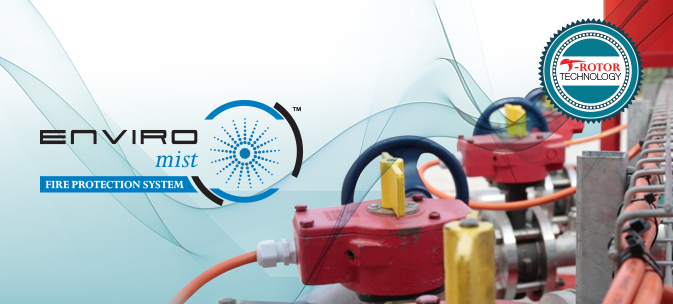
The EnviroMist™ RotorMist Fire Protection System is based on innovative Rotor Technology that generates very fine water mist with advanced firefighting capabilities, rated to extinguish Class A, B, C and F fires. The firefighting effectiveness of water is directly proportional to its surface area that comes into contact with fire.
Due to the microscopic droplet size (55 – 75 µm) achieved with this technology, the surface area of the water is greatly increased (by about x 2000 when the droplet size is 65 µm) and still has enough kinetic energy to overcome fire convection currents.
EnviroMist™ extinguishes fire mainly by:
- Cooling (heat absorption)
- Displacement of oxygen & dilution of fuel vapor (inert gasses form as water expands at a ratio of 1750 to 1 when converting to steam)
- Attenuation of heat radiation (preventing fire from spreading to an unignited fuel surface)
EnviroMist™ Functioning Principles
The EnviroMist™ RotorMist Fire Protection System was designed in accordance with NFPA 750 (Standard on Water Mist Fire Protection Systems) as an alternative to other systems using halons, CO₂ or other gases and substances harmful to the environment, as well as sprinkler or foam systems using large quantities of water.
RotorMist is a low pressure, single fluid system (mixture of water and gas is provided through one pipeline), which uses water and pressurised nitrogen to create fine mist. As a result of automatic or manual activation the supply unit begins feeding the extinguishing medium to the piping.
Rotor units placed inside the water cylinder(s) create a mixture of water and pressurized nitrogen in a pulse manner. The mixture travels from the cylinders to nozzles through piping and is forced through the atomising holes in each nozzle so that the water streams collide, generating a dynamic stream of extinguishing mist.
The EnviroMist™ RotorMist Fire Protection System is mainly used in enclosed spaces and in temperatures above 0°C. Appropriately directed nozzles cover the entire surface of the protected object, or fill the room with mist (max 40m³).
The system discharge time is designed to be at least double the actual extinguishing time, as per NFPA standards. In accordance with NFPA 750 every system configured for the first time must undergo 1:1 trials.
* Note: For temperatures below 0°C it is possible to replace water with special extinguishing agent to enable the system to operate in temperatures down to -30°C, or have additional equipment preventing water from freezing.
**Note: It’s possible to install the systems in open space areas after consulting with the manufacturer and conducting a 1:1 test.
Supply Unit and Suppression System Components
The supply unit can consist of a single or multi cylinders varying in sizes (from 16,6L to 180L). The size and quantity of the cylinders depend on the total volume of water required.
Two or more cylinders are connected via a manifold to the pipeline. Storage cylinders are filled to a maximum of 72% with water and pressurised to 15 bar with nitrogen at 20˚C. Each cylinder comes complete with rotor units inside, valves, pressure switch and gauges.
Discharge Piping Network
Piping and hydraulic fittings must consist of 316 Stainless Steel and is used to connect the supply unit to the extinguishing nozzles. Diameters of pipes depend on number of nozzles and their total outflow surface factor.
Nozzles
There are different types of stream collision nozzles used in RotorMist Systems. The calculated Total Outflow Surface of each system helps to determine the number and type of nozzles, number of rotors, size of cylinders and piping diameter.
Spray patterns of the various nozzles must overlap to achieve 100% coverage for local protection systems.
Fire Detection and System Actuation
Different types of devices are used to detect fire and activate the extinguishing release valve. The type of detection depends on the type of protected object or area. RotorMist Systems use four types of detection systems:
- Pressure detection tube (two types available: ruptures at 80˚C or 108˚C)
- Fusible plugs (local pressure detection at plug – melt at specified temperature)
- Detection system based on thermocouples (automatic system – requires power supply)
- External detection system (actuating valve is a solenoid valve – triggered from extinguishing control panel that is connected to smoke, heat or flame detectors).
RotorMist Systems can be additionally equipped with manual actuation points.
Actuation units are as follow:
- Indirect differential valve (single cylinder supply units and pressure detection systems)
- Pneumatic actuator with spring (pressure detection with two or more cylinders – manifold)
- Solenoid valves (various types – diaphragm, ball or piston with electrical actuator)

